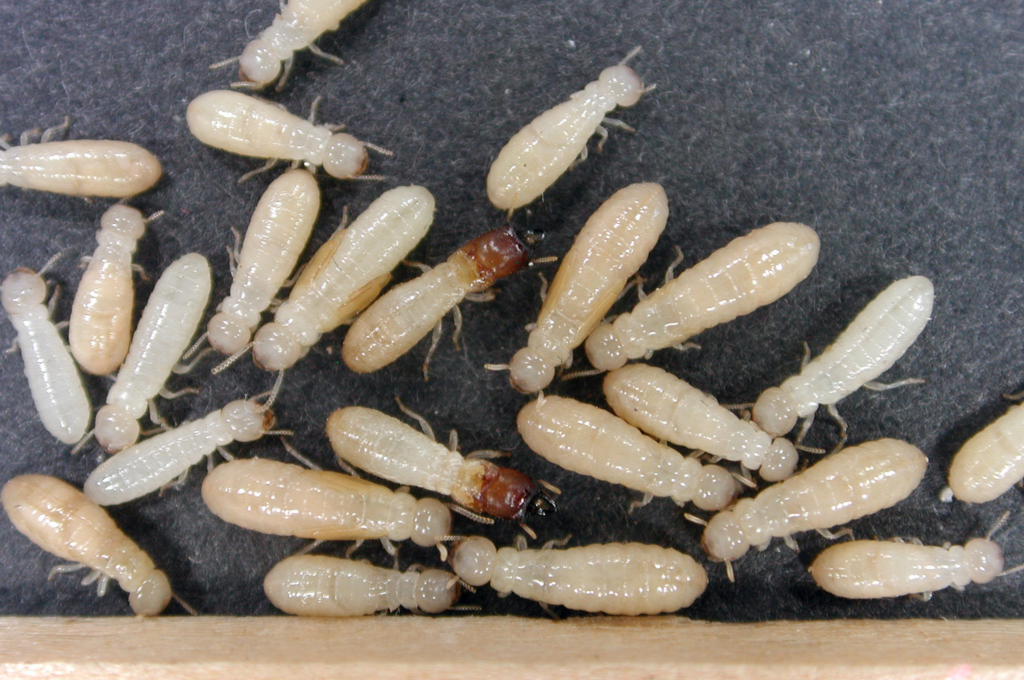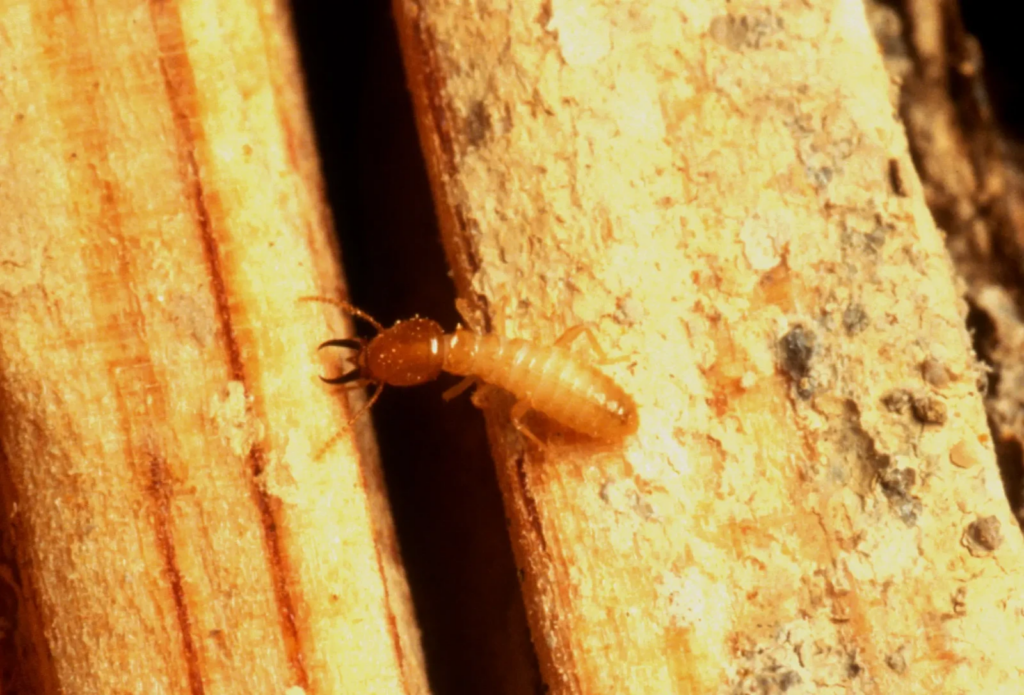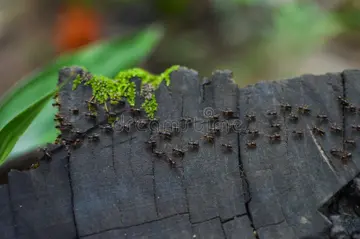Carpenter ants and termites are two pests that harm homes in the U.S. They both damage wood but in different ways. Knowing the difference is key to treating them right.
Nobody wants to discover they have carpenter ants or termites in their house. Getting them mixed up can lead to bad treatments. This guide helps you tell them apart. Knowing the difference keeps your home safe and your wood structures sound.
Key Takeaways
- Carpenter ants and termites both damage wood but do not eat it the same way.
- Incorrectly treating one pest as the other can worsen infestations.
- Visual cues like antennae and wing shape help distinguish these insects.
- Carpenter ants nest in moist wood, while termites consume it entirely.
- Professional inspection is vital for accurate identification and solutions.
Physical Characteristics and Behavior of Carpenter Ants and Termites
Knowing how carpenter ants and termites look and act is important. They are different in how they look, what they do, and how they harm wood.

Body Structure and Appearance
Carpenter ants have long, thin bodies with a clear waist. They are dark brown or black. Termites are pale and straight, with no waist. Ants are ¼ to ½ inch long, while termites are smaller, about ¼ inch.
Ants have bent antennae, while termites have straight ones. This makes them easy to tell apart.
Wing Differences and Identification
- Carpenter ants: Front wings are longer than the back wings; they shed one wing at a time when swarming.
- Termites: Their wings are the same length; they shed them in pairs, leaving mud tubes near where they enter.
Looking at wings near infested areas can tell you which pest is there.
Nesting Habits and Colony Structure
Carpenter ants dig in moist or damaged wood but don’t eat it. Their colonies start small and grow into more nests. Termites, on the other hand, eat wood and build complex colonies with different roles. Their nests are often hidden inside wood.
Activity Patterns and Seasonal Behavior
Carpenter ants are most active at night, looking for food like in kitchens. They swarm in late spring. Termites are active all year, swarming in warm, humid weather. Their constant chewing makes wood hollow and leaves mud traces, unlike ants’ clean tunnels.
Carpenter Ants vs Termites: Key Differences That Matter
Knowing the big differences between carpenter ants and termites is key to good pest control for ants and termites. Both are wood-destroying insects, but they act and eat differently. Carpenter ants make tunnels in wood for nests but don’t eat wood. They like insects, nectar, and crumbs instead.
Termites, on the other hand, mainly eat wood. They can break down cellulose. This eating habit changes how damage spreads.
- Damage Pace: Termite colonies grow slowly but cause gradual, widespread destruction. Carpenter ants expand nests faster but may cause localized damage.
- Geographic Hotspots: Termites thrive in warm climates like the Southeast and Southwest U.S., while carpenter ants are common in moist regions such as the Pacific Northwest and Northeast.
- Nesting Habits: Carpenter ants often nest outdoors but invade homes via moisture-damaged wood. Termites build colonies directly in soil or within wall voids, making their presence harder to detect.
“Misidentifying these pests leads to failed treatments. Properly distinguishing carpenter ants vs termites is the first step to stopping costly damage,” says the National Pest Management Association.
Acting fast is important. Homeowners in termite-prone areas should check wooden structures yearly. For carpenter ants, fixing moisture issues and sealing entry points helps prevent them.
Both need specific pest control for ants and termites plans. Spotting either pest early saves money and keeps buildings safe.

Identifying Damage Caused by Wood-Destroying Insects
Finding damage from carpenter ants and termites early is key to avoid expensive fixes. Knowing the signs can help homeowners stop damage before it gets worse.
Signs of Carpenter Ant Infestations
Carpenter ants make smooth tunnels in wood. Look for:
- Sawdust-like frass (wood shavings mixed with insect debris)
- Rustling noises in walls or wood structures
- Visible worker ants near moist or damaged wood
Evidence of Termite Activity in Your Home
Termites leave clear signs such as:
- Mud tubes on walls or foundations
- Discarded wings near entry points
- Hollow-sounding wood that sounds “crunchy” when tapped
- Warped floors or bubbling paint at infestation sites
Wood Damage Comparison: What to Look For
Carpenter ants make smooth tunnels along wood grain. Termites create rough tunnels with mud and feces. These signs help figure out which pest is causing the damage.
Structural Impact and Possible Costs
Ignoring pests can lead to big costs. Termite damage alone costs over $5 billion a year in the U.S. Fixing damage can cost $1,000 to $3,000 per home. Pest inspection services can find damage and suggest fixes like removing carpenter ants or treating termites.
Professional Extermination and Prevention Methods
Keeping your home safe from carpenter ants and termites is a mix of DIY and expert help. Knowing when to try it yourself and when to call a pro is key to keeping your home safe.
DIY Prevention Techniques for Homeowners
Simple steps can help prevent infestations:
- Remove stacked wood near foundations to eliminate nesting sites.
- Repair leaks and improve ventilation to reduce moisture buildup.
- Seal cracks in foundations and windows to block entry points.
- Store firewood 20+ feet away from structures.
When to Call Professional Pest Management Services
Call an exterminator for ants and termites if you see:
- Visible mud tubes or termite swarmers near the home.
- Wood damage spreading rapidly or affecting load-bearing structures.
- DIY efforts fail to stop infestation growth.
Treatment Options and Effectiveness
Experts use:
- Bait stations for carpenter ant trails targeting colonies.
- Soil treatments creating barriers against termites.
- Heat treatments for localized ant infestations.
Teams assess damage to pick the best method.
Ongoing Monitoring and Maintenance
Annual checks by licensed exterminators catch problems early. Homeowners should:
- Inspect wood regularly for tunnels or frass.
- Maintain drainage away from foundations.
- Replace damaged wood promptly.
Conclusion: Protecting Your Home from Wood-Destroying Pests
Knowing the difference between carpenter ants and termites is key. It helps you choose the right pest control. This way, you avoid wasting money on the wrong treatment.
Regular checks for pests are important. Both ants and termites like moist or damaged wood. Keeping wood dry and sealing holes helps prevent them.
Look for mud tubes, wood damage, or wings to catch pests early. While DIY steps help, seeing signs means you need a pro. Experts use special treatments to get rid of pests before they cause big problems.
Don’t believe myths that small infestations are safe or DIY fixes work always. Professional inspections give you the right plan. This mix of prevention and pro help keeps your home safe and valuable for years.
Carpenter ant and termite control
If you see the signs and are worried you may have an infestation of either insect, you need to contact a pest control company immediately. The professionals at Vinx Pest Control know exactly how to stop an infestation as well as prevent future ones from returning. We have years of experience under our belts and with our satisfaction guarantee, you can feel safe and secure in your own home once again. If you live in Dallas, TX, Charleston, SC or Greenville, SC, we can handle all your carpenter ant and termite problems. See pricing here.

FAQ
What are the key differences between carpenter ants and termites?
Carpenter ants have segmented bodies and don’t eat wood. They make nests in damaged wood. Termites, on the other hand, have straight bodies and eat wood. They cause a lot of damage by eating cellulose. It’s important to know the difference for termite and carpenter ant control.
How can I recognize signs of carpenter ants and termites in my home?
Carpenter ants leave sawdust-like frass and make rustling sounds. You might see worker ants too. Termites have mud tubes, discarded wings, and sound hollow. Pest inspections can help find them early.
What are the best methods for termite treatment and carpenter ant removal?
For termites, use chemical barriers, baiting systems, and wood treatments. Carpenter ants need direct nest treatment. Getting help from pest management services can make these methods work better.
When should I consider calling a professional exterminator for ants and termites?
Call a pro for big infestations, structural damage, or when DIY fails. Extermination for ants and termites by experts usually works well.
How can I prevent infestations of carpenter ants and termites?
Stop wood from touching soil, fix moisture, seal holes, and keep air moving. Regular upkeep and treatments can lower the risk of wood-destroying insects.
What are the possible costs from carpenter ants and termites?
Termites cost over $5 billion a year in the U.S. Treatment can cost $1,000 to $3,000 per home. Knowing about damage can help find the right treatment and avoid big costs.



